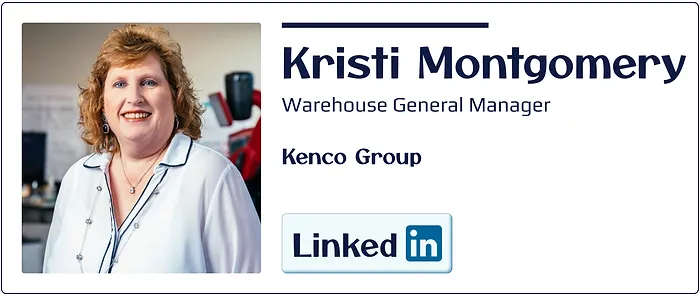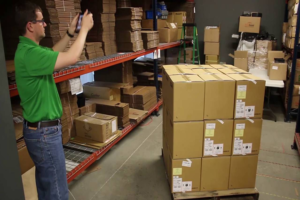Back up for a moment. What would be a typical situation as the result? Number of humans. And some of them we can’t address with this solution like We’re going to explore solutions for retailer chargebacks and the case study that’s a finalist in the Supply Chain Innovation Awards Competition at the Council of Supply Chain Management’s EDGE 2017 Conference in Atlanta this year. My guest to explain it is Christie Montgomery.
She is vice president of Innovation and R and D with Kenco Logistics Services. Christie, welcome. Thank you, Bob. So trace for me the beginning of this initiative. What was the initial challenge that you and a customer face that led you to seek the solution?
Yes. So our we’re very customer centric in our innovation. So we had a customer come to us and say, we would love to find some sort of solution that would help us with reducing our customer complaints, retail chargebacks, some way to prove that we didn’t cause the problem in the first place. And they had gone to their internal IT group, and the project was gonna be about a 2 year long project add on to SAP, they felt like. And, the pain point was just too great for them to wait that long.
And so our group took that on as a challenge, and we did some research and found that that was a global problem across our customer base. It wasn’t just the single customer, which in this case is the sealed air corporation. Rick Olson, who’s here with me today, presented us with the challenge, but it was a bigger bigger than just one customer. So it’s not something you had really looked into deeply before. We had not.
And and It certainly is an age old problem, but it hadn’t been brought to your attention to something that was in need of a solution. Yeah. So, Bob, if you think about it, a a third party logistics provider typically doesn’t see those chargebacks. Those are experienced by our customer directly as they ship to a retailer, and then the retailer takes the the money back off the invoice they receive. And so we never see those invoices, so we didn’t see the problem as greatly as they did.
So it it became a very strong pain point for them, to address. And and as we always find, a lot of their innovation, a lot of their IT resources are focused on the manufacturing process or the service they provide, not on their supply chain. And so that’s where we come in to help provide that that innovation around the supply chain. Okay. So once you had identified the problem, what was the first step you took toward warehouses were using digital cameras, taking photos, hoping to remember to download those photos into a laptop or a PC somewhere.
They would download 50 to 100 photos at a time. They would all have a name, something like dsc1034. So 3 months from now when the customer had the chargeback to find that individual picture was almost impossible. And so we realized that there had to be a combination solution of being able to capture the photo, immediately upload it to a cloud based solution that had, metadata tagged to it. So I knew exactly what I was looking for.
I could search for that specific photo on that specific date. So we formed some focus groups of people who were experiencing the problem and started interviewing them as to what they were doing today and how they saw a better a better future challenge. Let me back up for a moment. What would be a typical situation that will result in a retailer chargeback? What kind of thing?
So there’s a number of things, and and some of them we can address with this solution, like EDI differences. But things like the the label isn’t on the proper corner of the pallet, the pallet’s not shrink wrapped properly. The the documentation is not accurate that’s going along with the pallet. Pallet’s damaged. The pallet isn’t stacked properly.
It wasn’t loaded properly into the back of the trailer. So there are a number of possible options here that we can prove that the warehouse did it right with the load proof solution that we came up with. But you don’t know until later on that a charge back and an issue is going to arrive. Yes. So you have to proactively take a picture Yes.
Of every single shipment that comes through the warehouse. Yes. And then put a meta tag, metadata on that, and when it turns out to be a problem, you go find that. That’s correct. That’s a lot of pictures.
It’s a lot of pictures. So you had to make it very simple, very quick, very easy to use for a warehouse worker. Yeah. What was the obstacle to having prevented this type of solution before? It seems like a pretty self evident thing once you describe it.
Yes. I think and you’re right. It’s a very simple solution. I think the difficulty was in capturing the data that needed to be associated with those pictures. Mhmm.
And so what was happening is you had a clerical person going in after the fact, trying to name them, put them in proper folders so that they would be searchable down the line. And and, you know, hopefully, you wouldn’t lose that hard drive on that computer and lose all of that data. So, it really be it’s really about the data and just housing it in a place that it’s easily accessible and and easily searchable. Did you encounter any snags along the way in terms of implement implementing the solution? We ran a quick 90 day pilot on the minimum viable product so that we could prove that it would work in the facilities, and then we had to take it to a developer who could develop the full blown solution.
So we partnered with a start up, and so there were some just inherent challenges in working with a start up company, lack of resources, project management, things like that. But once it was rolled out to the field, you know, all we found is that people want more and more functionality. There’s not been any difficulty in using the product. It’s a simple mobile app that works on Android and iOS, and uploads information to the Amazon Cloud. So very easy, very, quick to access, and widely available technology, and so we didn’t have any issues there.
We have customers taking 5, 600 pictures a day and uploading them, and they have all the information they need to go search those a year later if they’d like to. So we’re finding it very useful. We really haven’t had a lot of issues. I guess probably the biggest one is just oftentimes, some of our customers, are are a little hesitant to push back on their customers that are retailers in a soft market. So when things are down, when, it’s not peak time for sales, it’s a little harder to to, you know, wanna push back on those charge backs, but, they also are finding that it’s reduced a lot of customer complaints even if they aren’t necessarily reducing the charge backs, which most of them are.
At least they’re proving to their customer that we have we have something where we can see, And so they reduced the number of charge backs in the 1st place, which is interesting. So the customer now knows they’re watching, which is a good, impact from that as well. What were the real world benefits that have been derived from this, implementation so far? So Sealed Air has seen a 95% customer complaint reduction. We’ve had customers who have saved over $20,000 a year in inbound trailer damage being able to prove that we didn’t cause that damage.
We’ve had DEA funds avoided by being able to prove that we have the proper licenses for the proper states. We’ve had documentation proof for the the Home Depot and the Lowe’s of the world who try try to say you don’t have the proper paperwork. So we’ve had a lot of really good positive benefits resulting from this solution. Needless to say, this solution can be rolled out to your other customers as well. Absolutely.
It can be rolled out to the wide world. So we went we went public with it and had a developer develop it that is selling it and marketing it as a separate solution. It’s not just a Kenco solution. You can go to loadproof.com and download it. Anybody in the world can download it.
Great. So it benefits the industry as a whole. Great story. Christie, thank you so much for sharing it with us and congratulations on being a finalist for the Supply Chain Innovation Awards at CSCMP. Thank you.
Fingers crossed. I have been speaking with Christie Montgomery of Kenco Logistic Services. Thank you very much for watching.







 1. Increases EPP, using budgeted line items.
1. Increases EPP, using budgeted line items. Millennial friendly technology, less onboarding time, very easy adoption – touch screen keypad, and 43% of Millennials already use IOS, familiar with Facetime, 85% of Millennials aged 18-24 own devices and 86% aged 25-34 own them, consume a lot of video on their smartphones, and are highly comfortable with this medium, they understand and like apps.
Millennial friendly technology, less onboarding time, very easy adoption – touch screen keypad, and 43% of Millennials already use IOS, familiar with Facetime, 85% of Millennials aged 18-24 own devices and 86% aged 25-34 own them, consume a lot of video on their smartphones, and are highly comfortable with this medium, they understand and like apps.